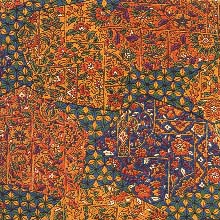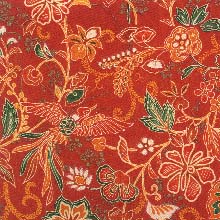Dye (p. 128 )
1. Produced in Hondo City, Kumamoto Prefecture.
2. Characteristics: Chintz dyeing usually applied to cotton or silk cloth. The designs look exotic as they are the flowers and birds of Persia, India and Netherlands.
3. Uses: Clothing, sashes.
4. History: "Sarasa" dyeing was first imported from China (Ming Dynasty) through the official trade in the early 15th century. Much more was imported since the end of the Muromachi Period(middle and late 16th century) when "Nanban Sen"(literally, ship of southern barbarians), European ships reached Japan. In the middle of the Edo Period, the Japanese imitated the imported "Sarasa" and dyeing was produced in several cities such as Nagasaki, Sakai and Kyoto. "Amakusa Sarasa" was one of them and was first dyed in the 19 century by 2 local men who learned the dyeing technique from Dutchmen and dyers in Kyoto. The dyeing continued to the early Meiji Period but ceased in the 20ユs of Meiji. In the early Showa Period, the dyeing technique was revived by Hatsuyoshi Nakamura whose 2 sons have been inheriting the technique.
Dyeing Method
For sources of dyes such plants as "Yamamomo"(Myrica rubia) and "Kihada"(Phellodendron amurense) and such minerals as "Bengara"(red oxide of iron) and "Prussian blue"(Ferrocyanide of iron) are used. Paste resist is properly applied on paper patterns today to produce a number of colors.





